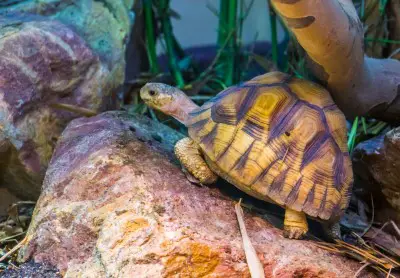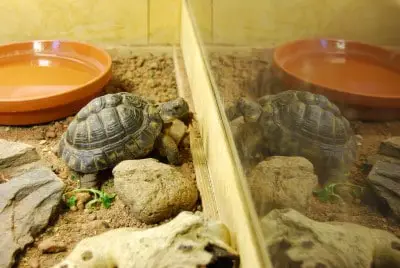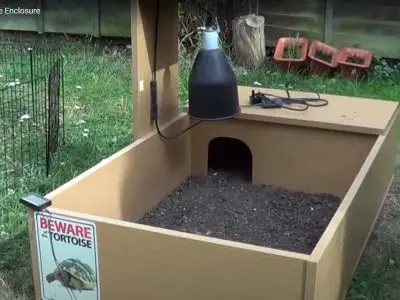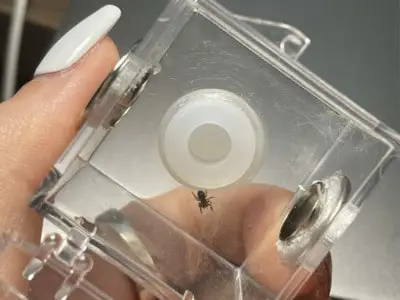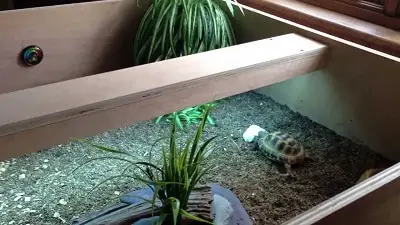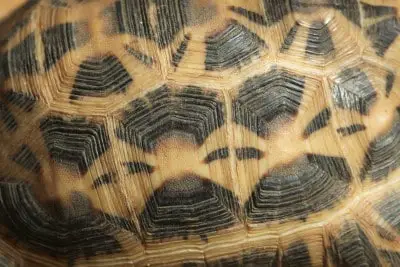Perhaps, one of the boldest moves to make as a pet lover is to get a tortoise. They are exotic creatures, and word has it that they are pretty expensive to purchase and maintain. Therefore, if you are a first-time owner, you would need to know what to expect in costs and expenses.
Acquiring a may tortoise costs between $50- $1000. Setting up comfortable housing with amenities may cost between $70- $400, depending on what you’re providing for your tortoise. Finally, the average annual running costs may vary between $150- $600, depending on its needs.
Here are some of the details you need:
| Product / Service | Initial Cost | Yearly Cost |
| Your Tortoise | $50- $1000 | |
| Enclosure | $70- $150 | |
| Heating and Lighting | $70- $200 | |
| Water Dish | $5 – $10 | |
| Hide / Shelter | $5 – $10 | |
| Plants | $5 – $10 | |
| Other Accessories | $10 | |
| Substrate | $10 – $20 | $10 – $20 |
| Food | $250 | $250 |
| Power | $180 | |
| Vet Fees | $150 | |
| Total | $475 – $1660 | $590 – $ 600 |
It is tasking to look for each pet tortoise and find out how much they each cost. Therefore, we have made it easier for you by breaking down all the initial and running costs to help you decide which species to buy. Read on as we give you all the insight you need.

What To Consider When Buying a Tortoise
Tortoises are not the ordinary mammal pets that most people have in their homes. They are reptiles; hence, they are more delicate and need more care from their owners. Before you buy one, there are some crucial factors to consider.
1. Species
There are hundreds of tortoise species roaming around in the wild, and several are found in people’s homes as pets. They are all exotic animals, which explains the price tags attached to them. The rule of the tortoise market is that exotic tortoises are much more expensive. You will likely find different species of the same size with different asking prices.
2. Age
You can buy either a hatchling or a fully grown tortoise. Compared to adults, baby tortoises are cheaper and easier to acquire. A baby can cost around $70 depending on the breed, while an adult will be more expensive, setting you back between hundreds to thousands of dollars.
The argument is that the owner invested a lot in the tortoise for it to grow. Consequently, many would instead go for a brand new hatchling and take care of them from scratch. Others would otherwise opt for the older ones to avoid the delicate nature of baby tortoises. The less the risk involved, the more you need to pay.
3. Supplier
Where to buy the tortoise from is also a significant decision. Your options are a breeder, private owner, or retailer. A breeder will offer you hatchlings, and you will be sure of the tortoises’ origin. On the other hand, a retailer may find it for sale from a breeder, and the long-chain may increase the tortoise’s price. You may also not know the tortoise’s origin.
With a private seller, the owner will be mainly looking for a good home for the pet. An added advantage is that you will have the tortoise plus its care kits, reducing the budget associated with buying them anew.
4. Dietary Needs
Various species have different requirements when caring for them. Although the variations are minor, they need other foods for the betterment of their health. It is best to consider the cost of the supplements and the vitamins that your pet would need in the long run.
5. Space
Take a look at the amount of space you have. It would be easier if you live alone and have a large area to share with your pet. Similarly, it is vital to consider your space to know which species to buy. Some tortoises tend to outgrow small indoor spaces. Therefore, you can go for the smaller species if you don’t have enough room when they get older.
6. The Law
Always check your pet’s legal status. Regardless of its price tag, it would be best if you were on the right side of the law. You wouldn’t want to get caught with an illegally purchased tortoise.
Read more: 14 Best Pet Tortoises For Beginners: Small To Large (With Pictures)
Some states have also banned the ownership of some endangered exotic breeds. Therefore, take a look at your official state’s site before you buy any tortoise breed. Even if the seller is a local breeder, it would be safe to confirm first. Have a glace here to know what your state says about exotic pet ownership.
Various Tortoise Species and Their Initial Costs
Obtaining a pet tortoise is a life-changing and exciting decision, mainly if you are a first-time keeper. You need to know how much various species go for and all the related costs you will incur as you embark on the journey of tortoise ownership. Given how tasking the entire selection process is, we compiled a comprehensive list of the most common tortoise species and their price tags.
Galapagos Tortoise
The Galapagos tortoises are endangered. That is why the United States authorities require that you must follow the due process before owning one. Since the species is one of the tortoises at risk of extinction, its price is quite inflated.
A juvenile Galapagos tortoise can cost you anything between $3,000- $9,000, while an adult female can set you back a whopping $20,000 or more depending on its size and age. Male adult Galapagos on the other hand, are rare to find on sale, but you can find a big mature one at a staggering $60,000.
Leopard Tortoise
The African leopard tortoise is known for the distinct leopard-like spots on its shell. Most Leopard tortoises are medium-sized, but some subspecies may have various sizes. These species are primarily docile; hence, you can keep them with other torts of the same breed.
Hatchlings of this reptile go for $150- $200, while adult Leos are more expensive to purchase (the asking price can be as high as $2,000). Leopard tortoise costs relatively low, and you can get one from your nearest shop or dealer.
Sulcata Tortoise
It is one of the giant tortoises in captivity and is said to have the best adaptability rate no matter the environment you place it. Since the reptiles can grow heavy, you should keep them outdoors and build a solid tank that they cannot break easily, but it should be big enough to accommodate them.
Also, provide sufficient place for burrowing and digging. Sulcata is also known as the African Spurred tortoise and is the third most giant tortoise after the Aldabra and Galapagos. Its young ones costs between $50- $7500 and a mature one will go for about $1,000- $2,000.
Egyptian Tortoise
This species is a desert animal native to Libya, Egypt, and parts of Israel. It is among the most miniature tortoise breeds available, with lengths of about 6 inches. The animal is also endangered in the wild; hence, keeping them requires approval from relevant authorities.
The tort is naturally small such that even without outdoor space, you can still create room for it in your house. A younger Egyptian tortoise would cost you approximately $900, while a grown one will be around $1,300 or higher. Given that they are at-risk reptiles, their prices are likely to shoot up.
Pancake Tortoise
Unlike other tortoises with dome-shaped shells, Pancake tortoises have a somewhat flat shell. Their carapace is flexible, enabling them to squeeze between rocks away from their predators. You can get a Pancake tortoise from a breeder and not in the market. This tortoise can be an ideal choice for a beginner and even veteran keeper, and they usually go for $600- $1000.
Aldabra Tortoise
This is the largest tortoise species after the Galapagos. These guys may grow huge to over 100 pounds; therefore, you may have to get them an outdoor enclosure. In some countries, keeping such tortoises is illegal, and if the authorities find out, you may be charged with unlawful possession of an endangered species, even when you obtained it from a trusted source.
Baby Aldabra tortoises’ price tag is at $300- $1,300, with the mature ones going for up to $ 20,000. The more giant the tortoise, the more expensive it becomes. Therefore, most people would instead buy a hatchling to feed and nurture on their own.
Greek Tortoise
This reptile dwells along the Mediterranean and in the Middle East. It is also known as the Mediterranean Spur-Thighed Tortoise and grows to an estimated ten inches. Being one of the most miniature tortoises makes it easy to maintain since it can fit either indoors or outdoors if you don’t have enough space in your house.
The tort is friendly; hence, a suitable choice for beginners. Hatchlings of this species can cost roughly $40, but older ones can fetch about $250 or more depending on the size.
Marginated Tortoise
Marginated Torts are very attractive with rich colors when they are juveniles, but as they grow, it fades gradually, leaving an appealing tinge on the shell and scutes, enough to capture your attention. The reptile isn’t threatened, thus is readily available for petting. You can keep it indoors until it is mature enough to survive outside.
One advantage of this species is that they are hardy animals and live well even in harsh environments. This tortoise species ranges from $200- $500, with hatchlings selling even below $100 in some places.
Red-Footed Tortoise
These species are found in most Caribbean Islands and live mainly in South America. They have distinct red spots on their limbs, just like their name reveals. Red foot tortoises are medium-sized; hence, suitable for beginners. There are also subspecies of this tortoise that are red-headed, earning them the title Cherry-head Tortoises. The reptile isn’t entirely herbivorous but also feeds on insects and mites.
Offspring of these torts sell at around $140- $170, whereas adults range from $200- $500.
Hermann’s Tortoise
Hermann’s tortoise is very common among pet tortoises owners because of the unique personality that quickly adapts to living with humans. It may also live unexpectedly longer, giving you more time to enjoy its company. There are also cases of them outliving their owners. The two main Hermann’s tortoises’ subspecies that exist include the Eastern and Western Hermann’s. However, there used to be another breed (the Dalmatian Tortoise) that is a few inches longer and shared most characteristics with the Western Hermann’s Tortoise.
Both Western and Eastern variants have a lot in common, with only a few notable differences. The Western species are more rounded and jumpier than the Eastern counterparts. Adult Hermann’s can cost anywhere around $500- $800, and their young ones can be between $130- $170, with larger and older torts selling at higher prices.
Indian Star Tortoise
This tortoise is native to India and Sri Lanka and is known as the Indian star because of the star-shaped marks on its shell. Due to its stunning beauty, the Indian Star is in high demand, which explains its inflated prices. You can find the tortoise among breeders; however, it is illegal to export them, for they are assumed to be at high risk of extinction unless they receive proper monitoring.
The Indian Star is of the same size as the Greek Tortoise, but it is more expensive due to the export restrictions. These reptiles are easily adaptable, making them beginner-friendly, and you can keep them in large numbers because they socialize amicably among themselves. Indian Star costs about $250-$400 for hatchlings and $2,000-$4,000 for adult tortoises.
Russian Tortoise
This species is also known as Horsefield Tortoise found in Eastern Europe and Central Asia. The reptile is small and may not need a lot of space, unlike giant Galapagos. Therefore, it is convenient for people who live in tiny homes and apartments. The tort is pocket-friendly, with newborns going for $50-$100 while mature Russians can scoop about $130-$180.
Yearly Tortoise Needs
Tortoises live for many years, and in some cases, outlive their first owners. They need delicate and dedicated care to ensure their survival. Apart from the initial purchasing cost, there is other essential stuff you need to acquire for them; some you can buy once, while others you will have to buy as they replenish. Take a look at other tortoise needs.
The Enclosure
The first consideration is where you will house your pet. There are several well-designed tortoise tables, with a good one ranging from $70- $150. You need to consider your pet’s size first since the prices vary depending on the size. Miniaturemaller and giant tortoises can use this enclosure. Alternatively, you may look up various designs and construct one yourself. All you need are the right tools and materials.
The advantage with a DIY enclosure is that you have the freedom to customize one depending on the available space and your tortoise’s size, and it helps that it is significantly cheaper. Bear in mind that tortoises tend to grow larger and outgrow their initial enclosure. If your tortoise usually is giant, be ready to transfer it to a larger table or relocate it to an outdoor enclosure. However, these housings are more expensive and tasking to purchase and set up.
Additionally, it would help if you had a substrate in the enclosure, either topsoil, mulch, or a combination of both. This addition may cost you anything between $6- $15 per bag unless the substance is specially made, which is more expensive. The bagful of a substrate can last up to 5 months. Different species need different substrate types; hence, your choice and the amount you use will vary depending on your pet. You can buy this substrate in an online store.
In contrast, you can have your pets in an outdoor setup, but remember that they may still need to stay indoors when it gets too cold, especially during winter. Having them outside gives them enough sunlight and space to roam around and breathe in the fresh air. To construct an outdoor structure, you need about $70- $100.
Heating and Lighting
Unlike mammals, tortoises need an external heat source to help get warm when the temperatures drop. They bask under the sun when in the wild; thus, if you keep them as pets, you may need to find them a heating source. Others prefer taking their enclosure outside for them to soak, but this may be tasking, and, in most cases, the climate may not allow it.
Secondly, if you keep them outside, you need to watch them and keep them safe from predators constantly. The best way to provide heat is to purchase a basking lamp that will release heat. Additionally, it would help if you had a UVB to give the tortoise with vitamin D. They need the nutrient for calcium synthesis for healthy bones and shells.
Some lights are manual, but the recommended way to heat their enclosure is by using a thermostat to make the system automated. Such a lamp may cost $11- $40 while the bulb goes at around $10. The higher the wattage, the more it will cost. If you also want to include a thermostat, you will have to invest another $15- $60 based on its make and the control levels.
Inclusively, your heating and lighting system will need you to inject anything between $70- $200. You may get a good deal here in a set, which is cheaper than buying individual items.
Food
By now, you are aware that the bulk of pet maintenance cost goes to diet. Compared to conventional pet feeds, the good news is that the tortoise’s food is relatively cheaper. Yearly, it may cost you approximately $250 or a little more if you add nutritional feeds like vitamins. Generally, tiny tortoises are more affordable to feed than larger species. To save some expenses, some owners let their tortoises graze around the compound for plants, only providing feeds for a couple of days.
Notably, not all tortoises will be receptive to fruits and vegetables. For tortoises originally from arid areas, experts advise feeding on plant matter, such as vegetables exclusively. Any other food may cause trouble with their digestive systems. It may only work for other forest tortoises, who love to occasionally eat fruits and meat chunks, including live insects or the typical dog/ cat food. Therefore, forest tortoises are slightly more expensive than desert tortoises.
Also read: What Do Tortoises Eat: 23 Facts You Should Know (Explained)
Power
You will use power to heat and light the tortoise’s enclosure. Your monthly bill may reach $15, given how many bulbs you use and their wattages. Other electronic appliances you use like heaters and automated systems may also add to this bill. To save on costs, you can keep the light on for around 10 hours a day and switch it off after that.
Similarly, you can turn on the heater only when the temperatures have dropped. You can also have a thermometer to ensure that the machines run only when the conditions are unfavorable. Your cost may be low or high depending on how many tortoises or enclosures you have and the number of bulbs/ machines, and their wattage.
Vet Fees
Many owners overlook it, but the visit to the vet is vital for your pet. Even when it seems fine, you still need to go for a yearly or semi-annual physical exam to confirm that everything is fine. If you detect a condition early, the survival chances will be high. Generally, a visit to the vet may be approximately $150. The figure may get higher due to tests if your tortoise requires more treatment.
Such visits are mostly less than an hour-long as the vet checks the vitals and discusses other health-related issues with you. Additionally, if your pet is in critical condition, you may need to dig deeper into your pockets by up to $5000. These conditions may be due to internal or external injuries that require surgery.
Additional Items and Accessories
Once you have your enclosure set up, there are additional items to include. You need to install a hideout or a shelter that costs around $20. They come in different shapes, sizes, and designs to suit your needs. Some owners use everyday household items like old containers and small cardboard boxes to save on the extra costs.
Another essential item to put in the terrarium is a food/ water dish. Without it, the tortoise’s food would mix with the substrate and cause digestion problems. Expect these containers to cost $4-$12 based on the material and the design. For some foods, you can use dispensers such that you won’t have to refill the dishes.
Other accessories to use in the enclosure are plastic plants and other décor items. They spruce up the tank, and the tortoises can play with them. Depending on the item type you want and its material, you can buy one at around $5- $15 per piece.
If you have more cash to spare, you can go for foggers or sprinklers. They are automated systems that help keep the enclosure humid for the tortoises. You won’t need to keep sprinkling water every time. These machines’ price tag is currently at $20- $80. Sprinklers are, however, cheaper than foggers.
Also read: 20 Tortoise Accessories (Must-Have + Nice-To-Have)
Budget For Your Pet-Tortoise
All pets come with their expenses, and unless you are a negligent owner, you may have to invest handsomely for their growth and development. The good news is that various species have different price tags; therefore, you are sure to find one that perfectly suits you and falls within your budget.
In most cases, we recommend baby tortoises since they are significantly cheaper than adults. Besides, you get the first-hand privilege to take care of them and watch them grow. Lastly and most importantly, check in with your local authorities, lest you purchase an illegal tortoise.



